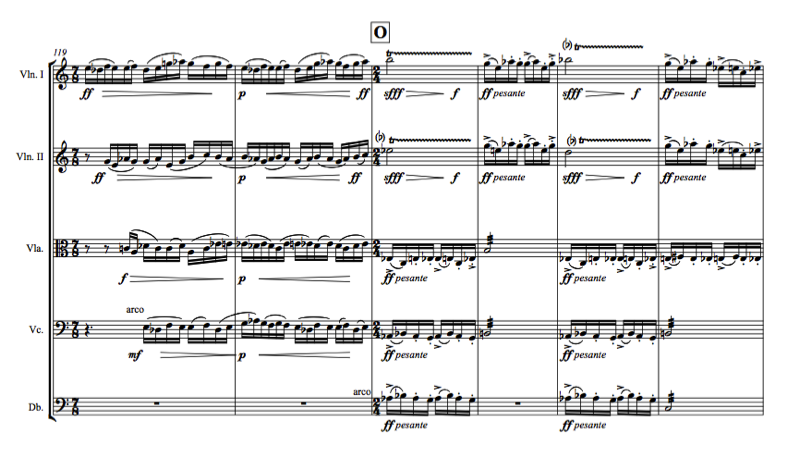Seed for String Orchestra: From Mock-up to Recording
1. Composition
2. Mock-up
3. Orchestration/MIDI-to-Sibelius
4. Parts
5. Contracting the Orchestra
6. Recording the Orchestra
7. Finalizing
1. Composition
Symmetrical modes (c, d, e-flat, e-natural, f#, g, a-flat, b-flat, b-natural, c)
Hindu rhythms, especially the deci-tala no. 53, sama
Thematic development through retrogradation
In Seed, a short musical fragment (consisting of g, e-natural, a-flat, g), first heard in the opening bar, is turned, twisted, lengthened, shortened, cannoned, retrograded throughout. The main motif's character draws on that captivating clashing minor/major thirds feel and carries it through the work.
Throughout the piece there are a number of hindu-inspired rhythms (drawn from Messiaen's writings on rhythm in his Treatise). The main theme, if simplified with accents, outlines an augmented deci-tala no. 53, sama: two quarter notes followed by two dotted-eighth notes. At rehearsal L, for example, the non-retrogradable Vijaya (dotted-eighth, eighth, and dotted-eighth) plays a prominent role. Sama and Vijaya are at the core of the piece's progression and development.
The spark for the piece was a short comment by Messiaen during the analysis of his own Turangalîla Symphony. It translates roughly to "as is the case in many classical pieces, the theme is much less interesting than its development." (Page 235, Tome II of Treatise on Rhythm, Color and Ornithology) Almost every texture in Seed is developed from the main four note motif.

2. Mock-up
The mock-up was created in Ableton Live, the DAW I use for all of my music -- soundtracks as well as concert pieces. Rhythmically, Ableton Live is incredible, the ability to create midi clips with any time-signature (lots of 5/8s) was indispensible for this composition.
The two sample libraries I couldn't have done without were Symphobia and LA Scoring Strings. Symphobia was useful in the earlier stages, drafting with a patch that covers the entire string section is useful for quickly trying new variations. LASS was helpful at working with each string instrument separately and mentally preparing for the notation process.
There is a great chapter in Karlin's “On the Track” about what to expect when going into the recording session after being so used to the mock-up. Reading that brief chapter really helped the mental preparation. Here's what the mock-up sounded like originally:
3. Orchestration
Sibelius is my go-to software when preparing the music for live performance. I export the midi files from Ableton to Sibelius manually -- the real detail work begins at this stage. The most important part of the orchestration was the detail in the bowings. Slurring the notes in fast passages was incredibly helpful in keeping the string players together and bringing out the accents, one of the most important aspects of the piece.
I used only the standard extended string techniques. Snap-pizzicato in the basses and sul-ponticello are as crazy as things get. There was no confusion during the recording about what kind of sound I intended. An example of the bowings can be seen below and heard at the 22s mark of the above video of the opening 25 bars:

4. Parts
After going through all the steps, it was still important to think about things like well-placed page-turns, clearly notated dynamics, and accidentals. I showed the parts to a violinist and a cellist and even the smallest of comments were incredibly helpful. As the recording process was rather grueling due to the rhythmically complex nature of the piece, the extra steps of preparation here really came in handy during the session -- there were few questions about my intentions in the score/parts.
5. Contracting the Orchestra
This was probably the easiest decision. The FAMES Macedonian Radio Symphonic Orchestra already has a fantastic reputation with video game scores and film scores. Their responses to the millions of questions I threw at them went a long way in helping me with my decision.
6. Recording the Orchestra
The first hour of the session was a learning experience as I got used to the process of recording different takes. I simply had to suggest dynamic and balancing tweaks to make sure everything was coming out as intended. Admittedly, this was not the easiest of tasks as there is so much going on in the music that it was sometimes hard to stay on top of everything.
The Karlin book, "On the Track" was again incredibly helpful for mentally preparing for recording. Ultimately, by this stage everything had to be perfectly prepared. There was little time to make any serious changes. Of course, asking for dynamic adjustments, shape, energy etc was normal but most everything seemed to be out of my hands -- the music itself, and especially the preparation, had to work.
Everything worked out wonderfully but the amount of risky textures and rhythmic craziness was a probably a little reckless in hindsight.
7. Finalizing
This part I wasn't prepared for at all. When receiving the session, there were a lot of choices with mic arrangements. I opted to stick mainly to the overhead mics, and if there were sections where balance really needed adjustment, I'd bring up the close mics from whichever instrument required more of a presence. Fortunately, little of this kind of adjustment had to be done.
The final mix is also pretty limited in terms of compression and EQ and reverb, I liked the natural qualities of the recordings. I kept the mix dry as more of the details can be made out. There were a lot of takes and figuring out which one to use simply took detailed listening time. Cutting the takes together was a long process but again, didn't turn out to be as impossible as I first anticipated.
All in all, this has been such a great experience and I hope that between the music itself and the description of the process, reading all the way down has been worth-while! Please feel free to send me an email at Levan@vel9studios.com if you have any questions.

